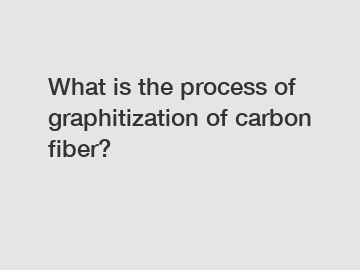What is the process of graphitization of carbon fiber?
What is the Process of Graphitization of Carbon Fiber?
Graphitization is a crucial step in the production of carbon fiber, transforming the material from a non-graphitic, disordered structure to a highly ordered graphite-like structure. This process significantly enhances the mechanical and thermal properties of carbon fiber, making it one of the most sought-after materials in various industries. Interested to know more about the process of graphitization of carbon fiber? Let's delve deeper into this fascinating transformation.
Graphitization refers to the rearrangement of carbon atoms within the carbon fiber matrix, leading to the formation of a highly ordered crystal lattice. This process takes place after the stabilization phase, during which the fiber is exposed to high temperatures while being treated with a stabilizing agent. Now, let's discuss the key points surrounding the graphitization process.

Point 1: Graphitization Temperature Range.
The temperature range during graphitization is typically between 2000 to 3000 degrees Celsius. This elevated temperature triggers the rearrangement of carbon atoms, allowing for the formation of graphitic layers within the carbon fiber. The duration of graphitization depends on several factors, including the type of carbon fiber, desired properties, and intended application. The longer the exposure to high temperatures, the greater the degree of graphitization achieved.
Point 2: Effect of Graphitization on Carbon Fiber Properties.
Graphitization significantly enhances the mechanical properties of carbon fiber, such as stiffness and strength. The highly ordered structure formed during this process provides greater resistance to deformation, making it ideal for applications requiring high strength-to-weight ratios, like aerospace components and sporting goods. Moreover, the graphitized carbon fiber exhibits excellent thermal conductivity, making it suitable for applications in the field of heat management and thermal dissipation.
Point 3: Challenges in Achieving Complete Graphitization.
Attaining complete graphitization poses several challenges. Carbon fibers are composed of thousands of individual filaments, each with its own degree of order. Achieving uniform graphitization across all filaments is crucial for overall material performance. However, due to variations in fiber diameter and precursor quality, achieving complete graphitization can be challenging. Factors such as fiber alignment, impurity content, and the presence of defects can also affect the degree of graphitization achieved.
Point 4: Various Graphitization Methods.
Several methods can be employed to achieve graphitization, each with its own advantages and limitations. One common method is the use of a high-temperature furnace, where the carbon fibers are heated in an inert atmosphere. Another method involves the use of lasers or electrical currents to selectively heat specific areas of the fiber, allowing for controlled graphitization. However, these methods can be time-consuming and expensive, making it essential to strike a balance between the desired properties and the practicality of the graphitization process.
In conclusion, the process of graphitization plays a vital role in enhancing the mechanical and thermal properties of carbon fiber. By subjecting the fiber to high temperatures within a specific temperature range, carbon atoms rearrange themselves into a highly ordered graphite-like structure. This transformation results in improved strength, stiffness, and thermal conductivity, making graphitized carbon fiber highly desirable in various industries. However, achieving complete and uniform graphitization across all filaments poses significant challenges that must be addressed. With further advancements in graphitization techniques, carbon fiber will continue to revolutionize industries, offering lightweight, high-performance solutions for complex engineering challenges.
Want more information on Gpc Columnar Recarburizer, Peach Shell Activated Carbon, Peach Shell Activated Carbon? Feel free to contact us.

Comments
0